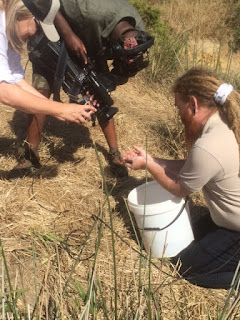We arrived at the river where Lynch addressed us on the surprising find: Heuningnes redfin minnow living in watercourses that seemed unsuitable for indigenous fish. The fish are a critically endangered indigenous species.
He paints the probable scenario of how these fish ended up here; how in the early years of earth as we now know it, the redfin went left instead of straight. As millennia passed and waters subsided, these fish became part of inland rivers and streams. The extreme drought conditions of the past four years have been bad news for the fish with many pools and sections of rivers drying up.
Some people can read palms, others the stars, and come up with a world of information. Watercourses and the fish found in them are a similar "book" for the person with the know-how, and it is fascinating to listen to an analysis.
A blog by the Overberg Renosterveld Conservation Trust (ORCT) on the redfin finding can be read here.
Of interest to us is that good agricultural practice works in the fish's favour. Lynch identifies Conservation Agriculture (CA) as the first. CA allows for greater infiltration of water into the ground and consequently, less pesticides run off into rivers. Secondly, lands which allow a buffer between crops and rivers allow for sediment carrying pesticides and other chemicals to be captured, again preventing them from spoiling water quality in the rivers.
We returned to the vehicles to continue our tour of the ORTC's work in the area.
This was the initial blog of The Agri Handbook, South Africa's biennial reference book for the agri-food industry where you will find points of reference for all subsectors which make up the agricultural value chain. Whether you are a new farmer looking at your options or an old hand wanting to diversify your operations but wondering where to start, you will find value here. Visitors are invited to also look at https://agribook.co.za/ where the latest chapters may be read.
Subscribe to:
Post Comments (Atom)

No comments:
Post a Comment